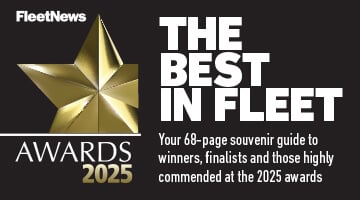This article has been taken from the FN50 2024 special report, providing insight into the UK’s biggest car, van and truck contract hire, leasing and fleet management.

Operating lease has recovered ground in the past 12 months to take a nearly 90% share of the market in terms of the ways van fleets have chosen to fund their vehicles through the top 50 leasing companies in the UK.
Operating lease accounted for 88.4% funding for vans this year, an increase of almost two percentage points compared with 86.6% last year.
It means finance lease has lost the bit of the ground it made up last year, falling from 11.7% to 10.3% this year.
It hints at a slight change in appetite for risk from a fleet perspective.
Finance lease sees the fleet take the residual value (RV) and depreciation risk, as well as having responsibility for settling the final balloon payment.
That means if a vehicle exceeds its forecast value, the fleet gets the benefit of the profits, but if it drops below its projected value the fleet will have to make up the shortfall.
With operating lease, the leasing company takes on the risk, which could be particularly important for fleets that are looking to take on more electrified vans, but are unsure of where things stand in terms of their future values on the used market.
Ashley Barnett, Lex Autolease senior manager strategic consultancy, says there has been a move away from finance lease for van fleets Barnett says this gradual shift has been driven by a stronger appetite and understanding of operating lease for vans.
He says: “We tend to see companies stick to the funding product they’re used to unless they have a supportive finance team behind them that can help unpick the intricacies of funding methods outside of operating lease.”
For many, operating lease is the comfortable, ‘go-to’ option – especially as new environmental regulations come into play and more businesses adopt electric vans.
The potential unpredictability surrounding the RVs of vans, particularly those used for highmileage or heavy-duty purposes, may make finance leases less attractive.
Lex, which does have a proportion of its van fleet through finance lease, has seen some customers weigh up the risk reward when disposing of vehicles.
Fleets that have the necessary dedicated focus and support may see bigger returns at endof-contract disposals.
These fleets might choose funding options, such as finance lease, that enable them to retain and dispose of the asset at the end of its contract.
Barnett explains: “In contrast, operating leases provide more predictable costs, without the concern around what will happen on disposal or having the resource to deal with the administration.”
Electric caveat
There is a caveat with thoughts around electric vans, however, particularly in terms of this switch influencing changes in funding methods.
While many forward-thinking fleets are looking to make the switch, the latest Leasing Outlook report from the British Vehicle Rental & Leasing Association (BVRLA) does note that the complications of running electric light commercial vehicles (e-LCVs) is prompting some operators to schedule another cycle of diesel vans, rather than make the switch to zero tailpipe emissions.
Or, in some cases, fleets have made the switch to EV for some vans and had to return them early due to them being too challenging operationally.
Contract hire (operating lease) continues to be the most popular option for van fleet funding as it provides low initial financial outlay, fixed costs, protection from depreciation risk and there is also the ability to reclaim some of the VAT associated with the lease.
However, finance lease can offer a bit more flexibility operationally for van fleets as they don’t run on a fixed mileage, compared with operating lease.
With operating lease, the fleet has to agree to a certain number of miles per year. The top 10 FN50 all have a heavy weighting towards contract hire (operating lease) representing the largest proportion of their business for vans.
Taking the risk
Four of the top 10 have 100% of their van fleet through operating lease, while two others are pretty close behind at more than 95% each.
It means the vast majority of funded van fleets are seeing leasing companies taking the RV risk, compared with finance lease.
There are some outliers within the FN50 with one top five business diversifying its funding portfolio with two-fifths of its van customers through finance lease.
However, Holman UK continues to be the van finance lease specialist in the UK with 100% of its business using this funding method.
The business has thousands of cars on its books, but a larger proportion of its client base is running commercial vehicles.
It allows Holman to concentrate on offering solutions to fleets based on flexibility and data.
Holman believes transparency is a key reason why it has won 20 customer contracts in the UK this year, accounting for around 4,000 vehicles, as well as the much-publicised BT contract which went live more than a year ago.
The business now sits in 16th place within the FN50 after being catapulted into the list of the largest leasing companies in the UK for the first time last year at 19th.
Rory Mackinnon, Holman commercial director, says: “I think the fluctuations year-on-year are much of a muchness generally between operating lease and finance lease.
“When we look at our customers, we know they’re looking for flexibility and control over the asset. Finance lease allows you to terminate the contract when you need to.
“You can exit at the right time when taking into account the residual value or maintenance and vehicle off-road curve for vans.
“Finance lease gives fleets the power of choice.”
Dedicated team
Mackinnon acknowledges that traditionally finance lease may require a business to have a dedicated fleet and transport team to manage more associated with running vehicles compared with operating lease.
However, Holman has built its business upon offering the convenience of an operating lease, with the flexibility that a finance lease affords.
Mackinnon says: “Over the past couple of years we’ve taken on around 70 clients that have converted from operating lease to finance lease and they haven’t reverted back.”
He believes there has actually been a “bit of an over-correction” with regards to electric vehicle prices, but managing the residual risk for eLCVs is possible, often by extending the lease over a longer term and keeping a close eye on data.
While second-life leasing is also looking to address the leasing industry’s challenges around managing used EV RV fluctuations, this solution does pose a trickier ask for electric vans.
The first e-LCVs are being significantly outperformed by newer models in terms of range and payload, which is making their useability on the second-hand market or for a second or third lease more questionable compared with cars.
Barnett thinks the increased adoption of electric vans is prompting some fleets to reconsider their funding options.
He says: “Since EV technology in the van space can be considered still relatively new, there are many unknowns and possibly misconceptions around residual values, battery life, and the rapid pace of technological advancement which may make outright purchases and finance leases less attractive.
“Operating leases allow businesses to transfer the financial risks associated with these uncertainties to the leasing company, reducing exposure to fluctuations in vehicle residual values.”
The FN50 research also shows that the percentage of contract hire agreements with maintenance for vans has actually fallen slightly over the past 12 months, moving from 62% down to 57%.
The trend is reflected for trucks too, with HGVs with maintenance falling from nearly 80% last year, all the way down to 60% for this year’s FN50 data.
Higher rentals
The BVRLA says that while fleets do appreciate the peace of mind and budgeting allowed by including maintenance with their contract hire agreements, leasing executives have made no secret of the fact that every element of a contract is being scrutinised for potential cost savings as customers are grappling with higher rentals due to fluctuating RVs.
There’s also an EV element here around electric vans for those fleets taking them on, as they have fewer moving mechanical parts, so don’t need to visit the workshop as often (although wearables like brakes and tyres are, of course, still a big consideration).
The BVRLA suggests the reduction in moving parts and seeming better predictability around service, maintenance and repair (SMR) costs may have led some fleets to feel more comfortable switching to a pay-as-you-go arrangement.
Barnett adds: “Whichever option fleets choose they can benefit from including maintenance and repair services.
“These funding options can often reduce the administrative and financial burden on businesses, making them more appealing in a market where the transition to zero emission vehicles is growing in line with the ZEV Mandate.
“The desire for operational simplicity and cost management, especially in uncertain economic conditions, is pushing this transition.”



















Login to comment
Comments
No comments have been made yet.